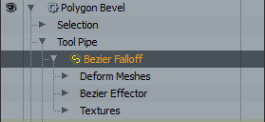Using Deformer Falloffs
Falloffs have a multitude of uses, mainly:
• As Deformers, where their area of influence can be assigned to deform the target mesh (similar to having a magnet that pushes and pulls a surface).
• To attenuate the effects of other Influences upon an item or mesh. For example, a modeling falloff can control the amount of influence a tool has on a surface.
• To control the degree to which a Force influences a Dynamic item (such as a Rigid or Soft Body). How the falloff affects other items depends on how you add it to the scene. The influence shape is related to its type.
Adding a Falloff as a Deformer
You can add a falloff item to a scene by using the Add Item function of the Items list, but the falloff has no direct effect upon any items in the scene until you link it to the target item. You can do this manually by using the Schematic view.
Modo offers a few ways to create these links automatically. For example:
| 1. | In Items mode, select the target mesh item. |
| 2. | In the Setup interface tab in the Deformers sub-tab of the toolbox, select the target falloff type in the Add Falloff Deformer list. |
This adds the falloff and links it to the selected mesh using the falloff's Deform Meshes input.
If you move the falloff now, Modo also moves any points within the influence of the falloff.

|
| A sphere primitive deformed by a linear falloff. |
You can adjust the initial Rest (undeformed) state by clicking the Setup button. (In Setup mode, the viewport frame has a yellow outline.) Position the falloff to where it should be in its undeformed state. After exiting Setup, you can animate or adjust the position of the falloff and deform the target mesh.
![]()
Adding a Falloff to an Influence
To have a falloff attenuate an Influence, you use the Deformers viewport where you can automatically create and link a falloff to the Influence in a single step. Within the viewport, select the target Influence item, right-click the item, and in the shortcut menu click Add Override > Falloff > Falloff Type to add it to the scene. Once added, you can animate the Position's Size and Range. The Influence only affects the target mesh within the bounds of the falloff. (You can invert this behavior, if desired.)
![]()
Adding a Falloff to a Force
You can also automatically link a falloff to a Dynamics Forces item to attenuate the effects of the force on dynamic items. To do this, in Items mode select the Force Item and use the Add Falloff option found in the Dynamics sub-tab of the same toolbox. With the falloff active, dynamic items within the bounds of the falloff are not affected to the full degree of the Force and attenuate to the core of the falloff where Items aren't affected at all.
![]()
Adding Falloffs in Procedural Modeling
You can add the procedural versions of falloffs in the Mesh Operations list. In the Model layout, you can find this in the lower half of the Mesh Ops tab, on the right side of the interface.
Note: For more information on the Mesh Ops tab, see Using the Mesh Ops Tab.
Most of the time, you add a falloff to the Tool Pipe of a mesh operation to modulate the effect of the operation.
You can add falloffs to procedural mesh operations the following way:
| 1. | In the Mesh Operations list, expose the tool's Tool Pipe input and click (Add Tool Pipe). |
This opens the Preset Browser, where you can select the falloff you need.
| 2. | Double-click a falloff to add it to the list. |
The image below shows a Bezier Falloff added to the Tool Pipe of a Polygon Bevel operation in the Mesh Operations list:

Click any link below to view the topic for a specific falloff.